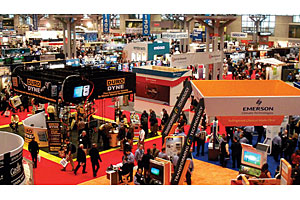
|
| Despite poor weather conditions, the 2014 AHR Expo drew a large crowd to the Javits Center in New York City. Photo by Jim Wheeler |
This year was billed as the largest AHR Expo in the Northeast to date.
The impressive turnout to the Javits Center occurred despite the record cold and snow that brought New York City to a virtual stop on the second day of the show. Yes, it was a mess even before the storm because the streets of Manhattan are almost all partially blocked by construction, double-parked vehicles, and the mass of pedestrians, taxis and buses. Somehow, everything ran quite well.
There were a large number of booths representing Chinese and Korean manufacturers touting their mini-split systems and various small parts and appliances. However, not many of our major domestic equipment manufacturers were present. Carrier Corp. was there with some large equipment for the first time in several years and Daikin displayed its own products and those of its recently acquired Goodman and Amana lines.
Of special interest was the announcement that Daikin’s Houston-based Goodman division is gearing up to start manufacturing its commercial line of variable-refrigerant volume products. What is interesting is that this appears to be the first of such Japanese-style products to be domestically manufactured and it signals a major push by that company to enter the United States in a big way.
Each of the major Japanese and Korean equipment manufacturers held special press conferences to announce new and improved products, but they seemed to be in lock step with each other. Each one was touting wall-mount, mini-split heat pumps with increasingly higher efficiencies, VRV systems that can operate in colder climates, and extremely long refrigerant lines and vertical drops.
Perhaps the most impressive numbers came from Mitsubishi, which displayed a mini-split with a 30.5 SEER rating and a VRV system that it says achieves its rated heating output to -11° F and still operates down to -25° F.
These systems are targeted for application wherever individual room temperature control is needed (offices, apartments, condominiums, hotels/motels, etc).
Another Japanese manufacturer that has decided to brave the U.S. market is Panasonic, which I didn’t expect because I had been told by another Japanese manufacturer several years ago that it would not come here. Surprise, surprise! Not only does Panasonic have a standard line of HVAC equipment, but it also offers digitally operated vent fans with several pluggable options that will meet any code requirement.
Of special interest is the fact the fans have built-in static-pressure drop compensation and can be switch-selected to meet various size requirements. These fans aren’t just for the bathroom market, but are touted for use in moving conditioned air into other unconditioned spaces such as closets and bathrooms where standard ductless systems aren’t generally applied. Good idea!
Although I didn’t really see much interest at the lines of Asian parts-and-pieces manufacturer booths, I did note something that may in fact be of future value. A Korean company called GCC Co. (info@r-pro.co.kr) displayed some nylon-coated aluminum refrigerant tubing for use in connecting outdoor (condensing) units to indoor (evaporator) coils.
As we watch the price of copper skyrocket, I often have wondered if something else could be used. The purpose of the nylon coating isn’t to serve as thermal insulation, but as an external corrosion protection for the aluminum. Currently, sizes are limited, so the tubing is for smaller equipment. However, the company says the cost is about 25% cheaper than its copper equivalent.
Next month: Refrigerants at AHR Expo.




